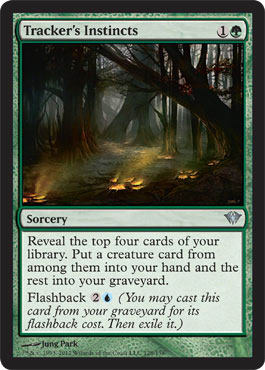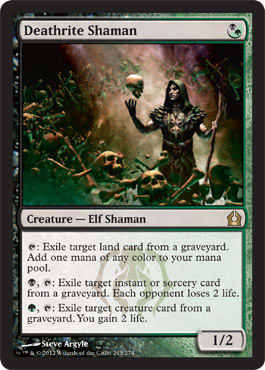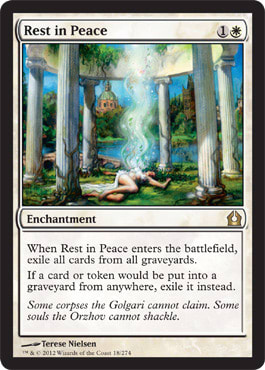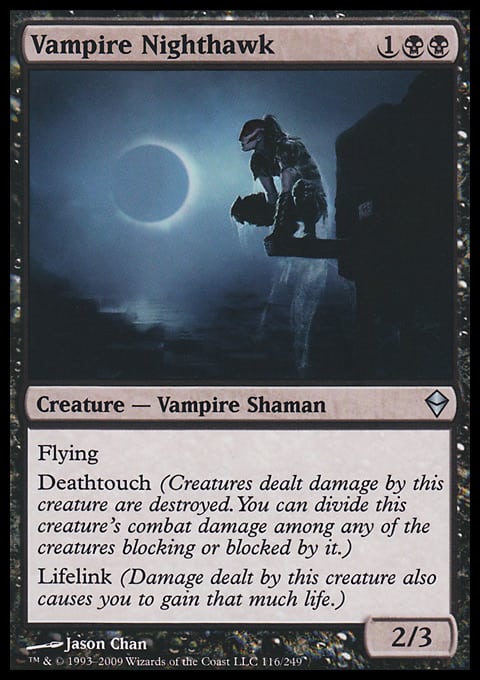Thanks to my parents’ giving me an excellent name, people frequently ask me, “Do you have any theories?” They seem to think this a hilarious thing to ask someone who shares a name with England’s greatest naturalist. I typically reply that I have several but that most of them aren't about Magic. As my Magic career progressed, we were able to add to the hilarity because of my obsession with the card Survival of the Fittest.
While I’m a believer in the Theory of Evolution, I’m certainly not a naturalist or any sort of expert on natural selection. I am, however, somewhat of an expert on Magic: The Gathering and the sorts of evolutionary processes associated with it. I’ve recently been spending quite a bit of time on Standard and specifically my Golgari deck, which I’ve been evolving every week as I learn more about the format and the current metagame. In Magic, it’s natural for the environment and the metagame in any given format to evolve, and your decks need to evolve along with them. The competitive Magic tournament environment is a terrific example of survival of the fittest, and one of the best ways to survive in Constructed is to constantly stay ahead of it or at least on top of it. If you fall behind, nobody’s going to be waiting up for you. Evolve or die.
Perhaps that’s a tad melodramatic, but you get the idea. As I mentioned in my last article, I played this deck at the TCGplayer MaxPoints 5K in Worcester:
"Lhurgoyfs!"
- Creatures (28)
- 4 Boneyard Wurm
- 4 Dreg Mangler
- 4 Gravecrawler
- 4 Lotleth Troll
- 4 Splinterfright
- 4 Ulvenwald Tracker
- 4 Jarad, Golgari Lich Lord
- Spells (8)
- 4 Grisly Salvage
- 4 Mulch
- Lands (24)
- 8 Forest
- 8 Swamp
- 4 Overgrown Tomb
- 4 Woodland Cemetery
- Sideboard (15)
- 4 Deathrite Shaman
- 3 Thragtusk
- 3 Sever the Bloodline
- 1 Acidic Slime
- 4 Blood Artist
The sideboard I used at that event was just slapped together at the last minute.
After going 7–2 at that event, I then had a week to prepare for the TCGplayer 50K in Indianapolis. At this point, I brought fellow Hall of Famer Rob Dougherty on board to help with the next step: evolution. While I was certainly happy to go 7–2, I felt that there was quite a bit of room to make the deck even better and to better prepare it for the metagame. If we wanted to do well at the 50K, the deck would need to change and evolve to an even more powerful form.
Rob proceeded to build the deck on Magic Online and put it through its paces against a variety of opponents. I told him that my biggest question was whether Mulch or Tracker's Instincts was the correct fit to go along with Grisly Salvage. Little did I know that trying out Instincts would have a butterfly effect on the entire deck. Even without blue mana, Rob was initially impressed with Tracker's Instincts. He immediately replaced three Forests with three Hinterland Harbors, and he was even more excited. After Rob told me about this, I put four Harbors into my deck and starting taking test draws.
This directly led to moving Deathrite Shamans into the main deck. Without Mulch, the deck was a little more mana-tight, and four Hinterland Harbors weren’t always enough sources of blue to reliably flashback Instincts, even with the option of grabbing one with Grisly Salvage. Not only did adding Shamans help with both of these issues, but I hoped it would improve Game 1 against beatdown and Reanimator (both a concern after the 5K), and it would create more room in the sideboard as well. One of the deck’s biggest weaknesses is that it’s a little bit slow. I hoped Shamans would help with this problem while Tracker's Instincts would keep the late game strong.
Of course, that meant removing some cards from the deck to fit in the Shamans. This was heavily influenced by what cards I sideboarded out frequently during the 5K. While I often took out either the Gravecrawlers or the Trackers, they were both so good in the matchups in which they were good that I was unwilling to take them out. I was trying to improve my early game by adding Shamans, not keep it static. Instead, I focused on my slowest cards: Jarad, Golgari Lich Lord and Boneyard Wurm. These were both cards I rarely was able to play before turn four, and even then, they weren’t usually very powerful yet. In particular, Jarad seemed to be an obvious candidate to have his number at least reduced—he’s a legend, and I can fetch him from my graveyard if needed in the late game. Out came two Jarad and two Wurm; in came four Shamans.
At this point, I started to wonder if even two Wurms were needed in the deck. Having a deck full of Splinterfrights, Jarads, and Wurms made me very vulnerable to Rest in Peace after sideboarding. While Wurms go well with the deck’s theme, they’re both slow and much less powerful than Splinterfright or Jarad. Of course, if I took them out, I’d need to find two cards to put in. After some brainstorming, Rob and I settled on Deadbridge Goliath. While it cost twice as much as a Wurm, it was usually bigger on turn four, didn’t care about Rest in Peace, and was more useful if it ended up in my graveyard.
Perhaps the most exciting thing about adding Shamans, Instincts, and Goliaths in favor of Mulches and Wurms was the increased number of cards that were useful in the graveyard, even as we reduced the number that we were being screwed by Rest in Peace. Now instead of having Mulches, Wurms, and lands being milled into my ’yard, where they would be dead cards, I was putting flashback, scavenge, and fodder for Shamans into my ’yard.
This is the deck we ended up playing in the 50K:
"Golgari B/U/G"
- Creatures (28)
- 2 Deadbridge Goliath
- 4 Deathrite Shaman
- 4 Dreg Mangler
- 4 Gravecrawler
- 4 Lotleth Troll
- 4 Splinterfright
- 4 Ulvenwald Tracker
- 2 Jarad, Golgari Lich Lord
- Spells (8)
- 4 Grisly Salvage
- 4 Tracker's Instincts
- Lands (24)
- 4 Forest
- 8 Swamp
- 4 Hinterland Harbor
- 4 Overgrown Tomb
- 4 Woodland Cemetery
- Sideboard (15)
- 4 Vampire Nighthawk
- 3 Thragtusk
- 2 Sever the Bloodline
- 2 Ultimate Price
- 2 Abrupt Decay
- 2 Vraska the Unseen
The impression I was left with after the 5K in Worcester was that Rakdos was a problem, Rest in Peace was a problem, and though I didn’t play against it, I was worried about the matchup with Reanimator. If the matchup with Rakdos was a problem, our changes helped. Shamans were useful, and the ability to bring in Vampire Nighthawks and removal seemed to really upgrade the matchup. I went 3–1 against B/R in the 50K, and it felt like a pretty decent matchup.
With only four creatures that absolutely needed to be boarded out against Rest in Peace and plenty of solid replacement creatures in the board, I won almost every game in which a Rest in Peace was played against me. I’ve now played this deck in twenty-three matches (obviously not counting byes,) and I have yet to play against a Reanimator deck. Either it’s not as big a part of the metagame as I feared or I’ve just been lucky. In either case, the main-decked Shamans lacked some of the impact I was hoping for and generally were sideboarded out unless I was playing against R/B.
The most unpleasant surprise for me at the tournament was the presence of many G/W aggro decks. While I won my featured match against Ben Rasmussen, overall, I was 1–3 against G/W. The problem was that I would lose the roll every time, and if G/W has a decent draw going first, it’s almost impossible for me to win before sideboarding. I have trouble blocking Knight of Glory, and I can’t block flyers in Game 1. Knight of Glory plus Silverblade Paladin or just an early Sublime Archangel are usually impossible for me to outrace. Game 2, I am able to go first, perhaps allowing me time to set up an Ulvenwald Tracker; plus, I am able to bring in removal, flyers, and life-gain. Of course, then I’m going second in Game 3, and things are hairy again. So yeah, it’s important for me to win the roll in this matchup.
In the end, I squeaked into the Top 64 with a record of 10–5–1. I went 7–2 on Day 1, and I was excited about my chances on the start of Day 2, as I was one of only ninety of the more than five hundred players in the event to advance. I was understandably devastated when I lost my first three matches of Day 2. Part of me wanted to throw in the towel at that point and find a remote corner to curl up and feel sorry for myself. My more stable, competitive self told the wussy half to suck it up and get back to business. I managed to win my next three matches, which allowed me to intentionally draw my way into the money.
Based on the Top 8 decks from the 50K, I didn’t play against an ideal reflection of the best of the current metagame. The top three decks were American midrange, and the rest of the Top 8 only included a solitary B/R deck as the only aggro deck. Of course, there were multiple Reanimator decks. Still, since I didn’t come terribly close to making the Top 8, it might be time to evolve my deck even more.
The main-decked card that I would most like to change is Deathrite Shaman. The most obvious swap would be to move it to the sideboard and move the Vampire Nighthawks into the main deck. This would allow me to continue to have access to both, while moving the card I’m always sideboarding out to the sideboard and the card that I’m always sideboarding in to the main deck. The Nighthawks give me a good flying blocker, an attacker with evasion, life-gain, and a great friend for Trackers.
The main strike against the Nighthawk is a mana-curve consideration. I already have eight 3-drops, and if I have 3 mana open in the late game, I can often just flash back Instincts. I’d much rather increase my options on turns one and two. I think the best cheaper options are Knight of Infamy and Diregraf Ghoul. Diregraf Ghoul is great because it’s both a 1-drop and a Zombie, but it doesn’t do anything in my graveyard, and my deck isn’t really about doing small chunks of damage. Knight of Infamy may improve my matchup with G/W a bit, but it’s not a Zombie, doesn’t do anything from my ’yard, and . . . hmm, perhaps I should try it. Among other things, I could see a creature with protection from white being a good target for scavenge. Also, I don’t mind missing my 1-drop, but passing on turn two usually means I’m falling way behind, even if I played a 1-drop.
"Golgari B/U/G Revision"
- Creatures (28)
- 2 Deadbridge Goliath
- 4 Dreg Mangler
- 4 Gravecrawler
- 4 Knight of Infamy
- 4 Lotleth Troll
- 4 Splinterfright
- 4 Ulvenwald Tracker
- 2 Jarad, Golgari Lich Lord
- Spells (8)
- 4 Grisly Salvage
- 4 Tracker's Instincts
- Lands (24)
- 4 Forest
- 8 Swamp
- 4 Hinterland Harbor
- 4 Overgrown Tomb
- 4 Woodland Cemetery
- Sideboard (15)
- 4 Deathrite Shaman
- 3 Vampire Nighthawk
- 2 Thragtusk
- 4 Ultimate Price
- 2 Sever the Bloodline
The bigger changes are to the sideboard. While Vraska the Unseen and Abrupt Decay are powerful, I found I was rarely excited about bringing them in. Vraska is slow, and unlike Thragtusk (the other card costing more than 4), it can’t do anything in my hand or ’yard. I brought Decay in pretty frequently, but most of the time, I just wished they were more Ultimate Prices, which are great against both B/R and G/W, especially since the cards I’m most concerned with are often 4-and 5-costing creatures in those matchups, such as Angels and Dragons.
Whether or not my Golgari deck intrigues you, the thing to remember is the importance of evolution. Often, by the time you see a deck on the Internet, the designer has already changed it. Great decks rarely remain static. In the race to dominate the metagame, you need to keep evolving so other decks don’t catch up or pass you.





























